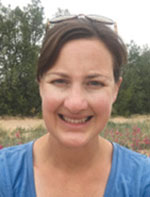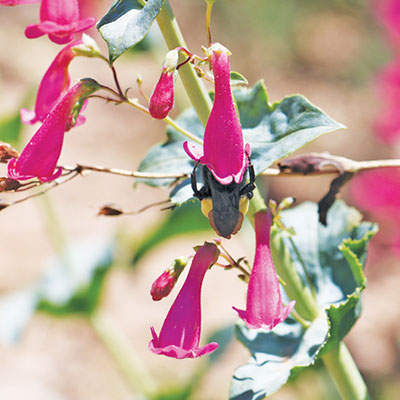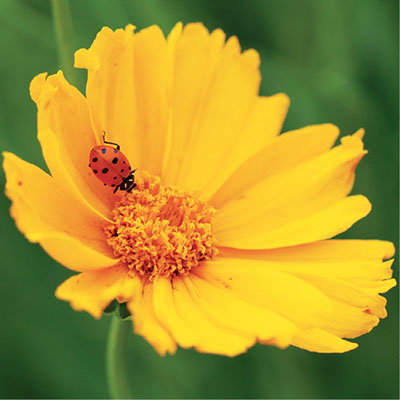Guide H-182
Miranda L. Kersten and Amanda Skidmore
College of Agricultural, Consumer and Environmental Sciences, New Mexico State University
Authors: Respectively, Program Manager, Agricultural Science Center at Los Lunas; and former IPM Small Farm Specialist, Department of Extension Plant Sciences, New Mexico State University. (Print Friendly PDF)
New Mexico has many native perennial flowering plants that can be grown for their aesthetic beauty and value in supporting our native pollinators. This guide will share the attractiveness of these flowers by insect group based on visual observations at NMSU’s Agricultural Science Center (ASC) in Los Lunas in 2018 and 2019. There are many annual (plants that complete their lifecycle in one year) native flower species that can be beneficial for pollinators in your landscape, but this guide will focus on perennial species (plants that live more than two years) that are native to New Mexico (USDA PLANTS Database; https://plants.usda.gov). This list is not conclusive or representative of all potential perennial pollinator plants in New Mexico, and other plants not included in this evaluation may also provide valuable pollinator resources. The plants in this guide were selected because of their uses in landscape planting and because they can likely be found at your local nursery.
Using perennial plants can have additional benefits in your garden, especially once they have become established. Perennial plants 1) provide floral resources yearly (some perennials may take several years before they produce flowers—just be patient with them), 2) are often drought-tolerant or can survive on lower amounts of water because they are adapted to our climate, 3) have lower maintenance since there is no need to replant them each year, and 4) can also attract other beneficial insects that can help suppress pest populations.
While this guide’s main focus is on native bees for our pollinator groups, they are not the only insect pollinators (for example, butterflies, flies, and beetles also pollinate plants). However, bees are considered to be the most efficient pollinators. They are the only pollinators that feed on pollen/nectar as larvae and adults. Some of our native bees are generalists that visit many types of flowers, while others are specialists that visit a specific genus or species of flower. For example, many bumble bees (Bombus spp.) are generalists that are active from early spring to late fall, while different species of native bees are active at different times of the year. For example, long-horned bees in the genus Eucera are active in the spring and early summer, while long-horned bees in the genus Melissodes are active in the late summer and early fall.
Note on managed pollinators: Honey bees (Apis mellifera) are non-native generalists. Their activity is based on temperature, so they may be seen when temperatures are between 55 and 100°F (13–38°C). While honey bees can be extremely valuable pollinators for agronomic crops, many of our native bee species are more efficient at pollinating native plants. Honey bees can compete with and crowd out native bees when resources are limited, so it is important to provide many diverse floral resources for pollinators.
We evaluated 22 perennial native plant species for their attractiveness to different beneficial insect groups (Table 1). These insects provide ecosystem services such as pollination and natural pest suppression. To best encourage these beneficial insects (i.e., natural enemies), plant a diversity of plants that bloom at different times of the year to provide for insects that are active early in the year and those active in the fall. Plant diversity is important because pollinators and natural enemies use color and flower shape to navigate while searching for resources. Insect vision perceives colors differently than human vision, often on the ultraviolet spectrum, and having many colors of blooms available can help attract different insects. Pollinator and natural enemy biology has evolved with plants, making some flower shapes preferred (Figures 1 and 2).
Figure 1. Tubular-shaped flowers, such as penstemons (Penstemon spp.), are accessible by moths, butterflies, and some long-tongued bees because these insects have a long feeding proboscis (tubular mouthpart) that can reach nectar resources (photo by Miranda L. Kersten).
Figure 2. Disk-shaped flowers, such as lanceleaf coreopsis (Coreopsis lanceolata), are open, making them accessible to many pollinator species (photo by Miranda L. Kersten).
These insects also need overwintering habitat, which includes plants that have varying sizes and textures. To learn more about identifying these beneficial insect groups, see NMSU Extension Guide H-172, Backyard Beneficial Insects in New Mexico (https://pubs.nmsu.edu/_h/H172/). Natural enemies feed on their insect prey as larvae, adults, or both stages, but supplement their diets with pollen and/or nectar. They can be encouraged to stay in your landscape by practicing conservation biological control (manipulating habitat to favor existing natural enemies). To learn more about conservation biological control and integrated pest management (IPM), see NMSU Extension Circular 655, Integrated Pest Management (IPM) for Home Gardeners (https://pubs.nmsu.edu/_circulars/CR655/).
|
Table 1. Perennial Plants and the Main Beneficial Insect Groups They Attracted in Our Observations at ASC Los Lunas1 |
||||||
|
Common Name |
Family |
Plant Height |
Flower Color |
Flower Shape |
Flowering Season |
Insects Attracted |
|
Giant hyssop |
Lamiaceae |
1–3 ft |
Purple |
Tubular |
Summer |
Large bees2, small bees, bumble bees |
|
Broadleaf milkweed |
Asclepiadaceae |
2–3 ft |
Pale green |
Sickle |
Summer |
Large wasps, large bees, small bees |
|
Showy milkweed |
Asclepiadaceae |
1.5–3 ft |
Pink |
Sickle |
Summer |
Large bees, small bees, large wasps, small wasps, ladybugs |
|
Horsetail milkweed |
Asclepiadaceae |
1–3 ft |
White |
Ovate |
Summer |
Large wasps, small wasps, large bees, small bees |
|
Butterfly milkweed |
Asclepiadaceae |
1–2.5 ft |
Orange |
Trumpet |
Summer to fall |
Small bees, small wasps |
|
Damianita |
Asteraceae |
1–2 ft |
Yellow |
Disk |
Summer |
Small bees, large wasps, small wasps |
|
Lanceleaf coreopsis |
Asteraceae |
1–2.5 ft |
Yellow |
Disk |
Late spring to summer |
Large bees, small bees, large wasps, small wasps |
|
White prairie clover |
Fabaceae |
1–2 ft |
White |
Cylinder |
Summer |
Large bees, small bees, small wasps |
|
Purple prairie clover |
Fabaceae |
1–3 ft |
Purple |
Cylinder |
Summer |
Large bees, small bees, bumble bees, large wasps |
|
Engelmann's daisy |
Asteraceae |
1.5–2 ft |
Yellow |
Disk |
Spring to fall |
Large bees, small bees, large wasps, syrphid flies |
|
James’ buckwheat |
Polygonaceae |
0.5–1 ft |
White |
Bell |
Summer |
Large wasps, small wasps, small bees |
|
Red dome blanketflower (Gaillardia pinnatifida) |
Asteraceae |
2 ft |
Yellow |
Disk |
Spring to fall |
Large bees, small bees, large wasps |
|
Wild bergamot |
Lamiaceae |
2–4 ft |
Purple |
Tubular |
Summer |
Large bees, small bees, bumble bees, large wasps |
|
Palmer's penstemon |
Scrophulariaceae |
4–7 ft |
White |
Tubular |
Late spring to early summer |
Large wasps, small wasps, small bees, bumble bees, ladybugs, syrphid flies |
|
Desert penstemon |
Scrophulariaceae |
2–3 ft |
Pink |
Tubular |
Spring to summer |
Large wasps, small wasps, small bees, bumble bees, ladybugs |
|
Rocky Mountain penstemon |
Scrophulariaceae |
1–3 ft |
Purple |
Tubular |
Late spring to early summer |
Large wasps, small wasps, small bees, bumble bees, ladybugs |
|
Upright prairie coneflower (Ratibida columnifera) |
Asteraceae |
1–3 ft |
Yellow to red |
Disk |
Spring to fall |
Large bees, small bees, large wasps |
|
Blue sage |
Lamiaceae |
3–5 ft |
Blue |
Tubular |
Late summer to fall |
Large bees, small bees, bumble bees |
|
Mule's ear |
Asteraceae |
1–2 ft |
Yellow |
Disk |
Summer |
Large bees, small bees, large wasps, small wasps |
|
Riddell's ragwort |
Asteraceae |
1–3 ft |
Yellow |
Disk |
Fall |
Large wasps, small bees, bumble bees, ladybugs, syrphid flies |
|
Copper globemallow (Sphaeralcea angustifolia) |
Malvaceae |
2–3 ft |
Orange |
Bowl |
Spring to fall |
Large bees, small bees, large wasps, small wasps |
|
MacDougal verbena |
Verbenaceae |
2–3 ft |
Purple |
Tubular |
Late spring to fall |
Large bees, small bees, large wasps |
|
1Many of these plants may also support other pollinators, such as hummingbirds, butterflies, and moths, as well as other natural enemies; however, these were not counted in our study. 2Large bees and wasps are those that are larger than 3/8 in. (10 mm), while small bees and wasps are smaller than 3/8 in. |
||||||
Other Resources
For more information on pollinators, beneficial insects, and their habitat needs, visit these resources.
Grasswitz, T.R., and D.R. Dreesen. 2012. Pocket guide to the beneficial insects of New Mexico [Online]. Las Cruces: New Mexico State University Cooperative Extension Service. https://pubs.nmsu.edu/insects/index.html
Grasswitz, T.R., and D.R. Dreesen. 2012. Pocket guide to the native bees of New Mexico [Online]. Las Cruces: New Mexico State University Cooperative Extension Service. https://pubs.nmsu.edu/bees/index.html
Grissell, E. 2010. Bees, wasps, and ants: The indispensable role of Hymenoptera in gardens. Portland, OR: Timber Press.
Holm. H. 2017. Bees: An identification and native plant forage guide. Minnetonka, MN: Pollination Press LLC.
Wilson, J.S., and O.J. Messinger Carril. 2016. The bees in your backyard: A guide to North America’s bees. Princeton, NJ: Princeton University Press.
This work is supported by the Crop Protection and Pest Management Program (grant no. 2017-70006-27189) project accession no. 1013838 from the USDA National Institute of Food and Agriculture.
For Further Reading
H-172: Backyard Beneficial Insects in New Mexico
https://pubs.nmsu.edu/_h/H172/
CR-655: Integrated Pest Management (IPM) for Home Gardeners
https://pubs.nmsu.edu/_circulars/CR655/
Pocket Guide to the Beneficial Insects of New Mexico
https://pubs.nmsu.edu/insects/index.html
Pocket guide to the Native Bees of New Mexico
https://pubs.nmsu.edu/bees/index.html
 Miranda Kersten is a Program Manager with the urban integrated pest management (IPM) program at NMSU’s Agricultural Science Center in Los Lunas. Her work focuses on pollinator and beneficial insect conservation, monitoring beneficial insects across urban landscapes, and managing IPM research projects.
Miranda Kersten is a Program Manager with the urban integrated pest management (IPM) program at NMSU’s Agricultural Science Center in Los Lunas. Her work focuses on pollinator and beneficial insect conservation, monitoring beneficial insects across urban landscapes, and managing IPM research projects.
To find more resources for your business, home, or family, visit the College of Agricultural, Consumer and Environmental Sciences on the World Wide Web at pubs.nmsu.edu.
Contents of publications may be freely reproduced, with an appropriate citation, for educational purposes. All other rights reserved. For permission to use publications for other purposes, contact pubs@nmsu.edu or the authors listed on the publication.
New Mexico State University is an equal opportunity/affirmative action employer and educator. NMSU and the U.S. Department of Agriculture cooperating.
August 2022 Las Cruces, NM




